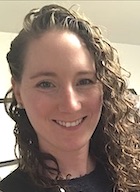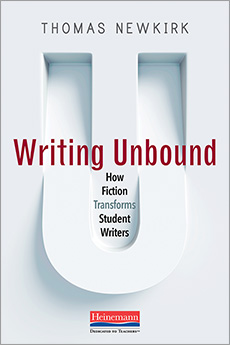How Fiction Writing Can Transform Students
Writing Unbound: How Fiction Transforms Student Writers
By Thomas Newkirk
(Heinemann, 2021 – Learn more)
Reviewed by Katie Durkin

It wasn’t until I took a creative writing course in college that I struggled with composition. Being given a blank slate to write any story I wanted was a challenge, and it took time for me to understand how to break the formula mold. With this course, I began to think about how much I liked writing fiction, and I wished I had done it sooner in my academic career.
Thomas Newkirk’s book, Writing Unbound: How Fiction Transforms Student Writers, explains to teachers the rationale for including fiction writing in curriculum for elementary, middle, and high school students. Through this book, I’ve now begun to think about how I can create opportunities for my students to not just study other people’s fiction, but begin to create their own.
Challenges to classroom fiction

Newkirk also interviewed teachers of writing and students who identify as fiction writers to include their testimonies throughout the book. Newkirk uses one student’s story as a basis for the second chapter, where he explains the power of fiction writing in developing young writers, while also revealing the harm done to students when they solely focus on other forms of writing.
Newkirk also first introduces in this chapter the harm done by rubrics, which is one example of what he calls “filters,” a term coined by one of his students to explain the restrictions in place when it comes to writing in school. Newkirk’s (2021) tone and word choice ending this chapter is strong as he states these filters can “contaminate” schools that are not focused on providing freedom to students through fiction writing (p. 24).
Chapter three asks readers to consider the ideas of “fiction vs. nonfiction” in schools, and how often students are asked to write more objective pieces that focus on other people’s literature, rather than create their own. Writing is also typically formulaic in schools because rubrics supposedly allow teachers to be more “objective” in their evaluation of writing (Newkirk, 2021, p. 31).
Moving beyond the challenges
But what if we allow students more “wiggle room” as Newkirk proposes? (p. 33). What if we found ways to allow students to be more creative in their assignments? Or gave them tools to create their own characters and storylines? Could fiction writing be another outlet for their emotions and feelings?
Newkirk argues that fiction writing will accomplish all of these goals and more because fiction writing can help also support students as they write in other genres. In the next four chapters, he outlines ways to do this.
Chapters 5 through 8 address the ideas of “Going Deep, Going Short, Going Long, and Going Close.” Going Deep in chapter 5 discusses the rationale that allows students to get into the heads of the characters they’re creating, essentially participating in a form of literary analysis. This also means that students may be creating characters as they think about psychology, using both their experience and inexperience as a foundation upon which their stories build.
Chapter 6 examines the short strategies teachers can use to incorporate more fiction into the classroom. Newkirk offers four ready-to-use techniques to help teachers think about small changes they can make in their classroom now.
In chapter 7, Newkirk offers ways in which teachers can help students play the long game with writing, including writing a novel. This chapter shows how teachers can use their time to help students have more freedom in “writing long” while still working within the constraints of expectations for evaluating student work.
And finally, Chapter 8 asks teachers to reexamine the ways in which they read student work. This chapter was particularly poignant because it asks teachers to take a step back to think about the ways in which they read and evaluate student writing, specifically looking at ways in which they may be doing harm to student writers. I loved this chapter because of one line from a student interviewed: “A teacher should be prepared to read something that they might not want to read – and to grade it just the same as if they loved it” (Newkirk, 2021, p. 120).
Newkirk calls on teachers to “be bigger than our normal reading selves” and to use his strategies to think about the ways we can be attentive, curious, and generous with student writers (p. 120).
Centered in the middle of this book is an interchapter where Newkirk tackles head on one concern that many teachers of writing have, myself included: the issue of censorship, specifically in regards to “Language, Violence, and Distress” (p. 75). While this was a short chapter, it was the one I appreciated the most. Newkirk uses testimony from teachers alongside usable strategies to help students include what they want to include in their writing without censoring them.
Newkirk ends his book with a credo, asking teachers to think about why they became English teachers. I won’t reveal his reason why because a book review is meant to get you thinking about reading the book, but for me, Newkirk’s assertion was spot on. I appreciated his theories and honesty throughout the book. At the end, he encourages readers to reflect on their own work as teachers and writers and how they plan to use what he has communicated in this book in the future.
Giving students a voice
One of the things I enjoyed most about this book was the prominence of student voice. Threaded throughout each of the chapters, Newkirk includes direct quotes from student interviews. Many of the chapters cited students talking about teachers who confined their thinking and writing. But as one student pointed out, not every story or writer has the same writing process.
So, why are we teaching students that all writers think and write in the same way? As I move forward with new knowledge from this book, I want to continually ask myself: how can I provide more freedom for my students to truly understand themselves as fiction writers and tap into their imagination?
Newkirk’s words, and the words of the students he interviewed, are a call to action. He provides teachers with the rationale for including fiction writing in their curriculum and uses students as the catalyst for teachers to change their thinking.
This book was quick and fast-paced, where Newkirk lays the foundation for the need for fiction writing in the classroom. While I would recommend this book for teachers, I also think it would be beneficial for curriculum coordinators and administrators to read because Newkirk brings to light a gap that may exist for many curricula.
While reading this book, especially the interviews Newkirk did with students, I kept thinking about how many writers or creative minds weren’t fostered in the classroom because of the lack of opportunities to write fiction. If we offered students more time in school to write with guidance from teachers and peers, how many more stories would students be able to share with the world?
I want to end with a note of gratitude to Thomas Newkirk as a writer, thinker, and beyond. At the end of this book, he acknowledges that readers are allowed to interpret and understand this book from their own stance. Thank you, Thomas Newkirk, for pushing my thinking and for allowing me space to grapple with your ideas and think about how to implement them in my own teaching space.
I hope fellow teachers and others will read Writing Unbound for themselves to understand the importance of making space for fiction writing in our classrooms for our students.
Dr. Katie Durkin (@kmerz610) has been teaching middle school students for over a decade, and currently teaches Reading Workshop at public Middlebrook School in Wilton, Connecticut, where she is the 7th Grade Team Leader.
Katie is a zealous reader of middle grade and young adult books and enjoys sharing her love and passion for reading with her students. In 2022 she earned her doctorate from Northeastern University, where her dissertation research examined the impact of classroom libraries on middle school students’ reading engagement. She was the 2020 recipient of the Edwyna Wheadon Postgraduate Training Scholarship from the NCTE. She writes regularly for MiddleWeb and in early 2023 launched a podcast, That’s Novel Reading.






























